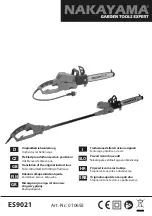
12
PARALLEL GUIDE (See Fig. D)
The parallel guide is used for making cuts parallel to a work-piece
edge at a chosen distance and can be used from either side of the
base plate (9). Slide the parallel guide (19) arm through the fixture(11)
to achieve the required cutting distance and tighten the clamping
screw (13) with the small “L” spanner to lock into position. Do not
over tighten. The parallel guide enables exact cuts along a workpiece
edge and can also be used for cutting parallel strips.
Note:
Since the parallel guide clamping screw is spring-loaded, the
operator should take care when unscrewing it completely as to avoid
losing the screw and spring.
SAWDUST REMOVAL (See Fig. E)
Your saw includes a vacuum adapter (20) that attaches to the dust
extraction outlet (7) on the saw. This adapter port can be attached to
a vacuum cleaner (sold separately). The use of the vacuum is strongly
recommended as it keeps the work area clean, dramatically increases
cut visibility and reduces airborne dust. It also keeps dust out of the
working elements of the guard.
Note:
If using the saw without a vacuum attached, in some
circumstances after lengthy operation, dust can accumulate at the
rear of the base and prevent it from reaching full depth. You can
prevent this by occasionally shaking the dust out.
PLASTIC BASE PLATE COVER (See Fig. F1, F2)
Your saw includes a plastic base plate cover (21). Attach it to your
saw’s base when you are cutting work pieces that have delicate
surfaces (finishes) such as vinyls, plastics, fiberglass, laminate
flooring and tiles that could easily be scratched by the steel base.
Operation
TRIGGER SWITCH (See Fig. G)
The on/off switch is locked off to prevent accidental starting. In order
to turn the machine on, depress and hold the lock off switch (6),
then depress the on/off switch (1) and release the lock off switch.
Your switch is now on. To switch off, just release the on/off switch.
Note:
When the machine is not in use, the lock off switch rests
against the blade guard in order to block the plunge function and
prevent the blade from being exposed unnecessarily.
SET THE BLADE DEPTH
Note:
The correct choice of cutting depth can improve ease of cutting
and cut quality.
Always use the minimum cut depth that is required for your particular
cut, which should just cut through the material plus a small allowance
e.g. 3mm.
Excessive cutting depth increases splintering in wood, chipping in tile
and causes severe chatter in sheet steel and aluminum (which can
quickly blunt the blade).
Maximum depth can be used when cutting internal cut-outs in wood
as this reduces the overcutting required.
1) Determine the desired depth according to the thickness of the
material plus a blade allowance of 1/8” (3 mm).
2) Unlock the depth of cut adjustment and lock lever (8). (See Fig. H1)
3) Slide the depth of cut indicator to the desired depth of cut. Lock
down the depth of cut adjustment and lock lever (8). (See Fig. H2)
When plunge or pocket cutting into the middle (or interior) of the
work piece, through the narrow slot, you can easily see the cutting
mark you draw and the location where the blade will plunge into the
2
3
4
1
2
Содержание Versacut WU420
Страница 3: ...9 10 11 13 14 15 16 2 23 1 8 12 4 3 7 5 6 17 18 3 19 20 4 3 17 18 3 10 4 A B1 B2 C D E...
Страница 4: ...22 J1 J2 J3 J4 J5 J6 16 21 8 5 6 1 D E F1 F2 G H1 H2 I...
Страница 5: ...J5 J6 K L M N...
Страница 56: ......
Страница 57: ......
Страница 58: ...Copyright 2013 Positec All Rights Reserved 2PSC15APK11003A0...













































